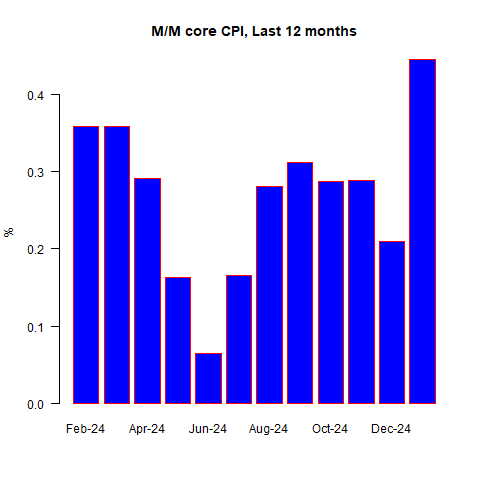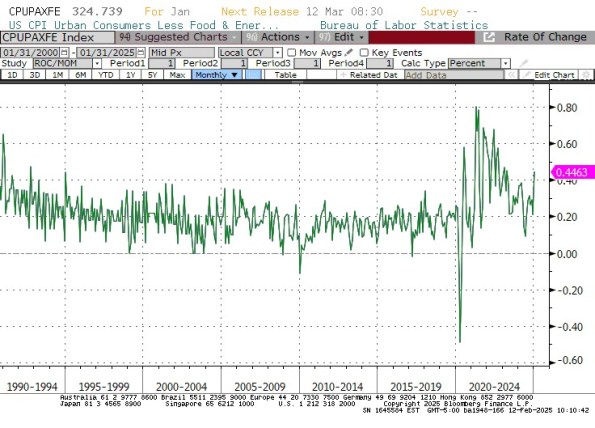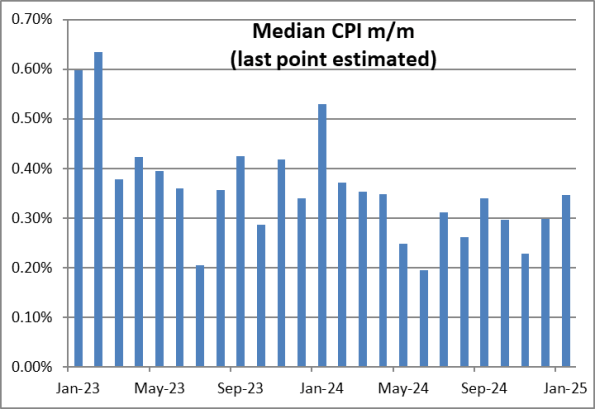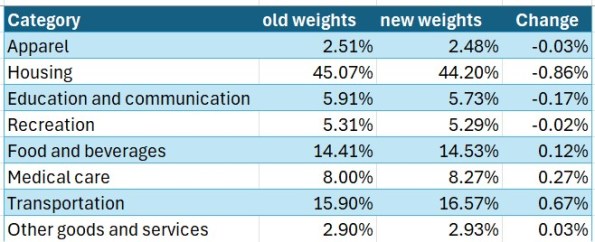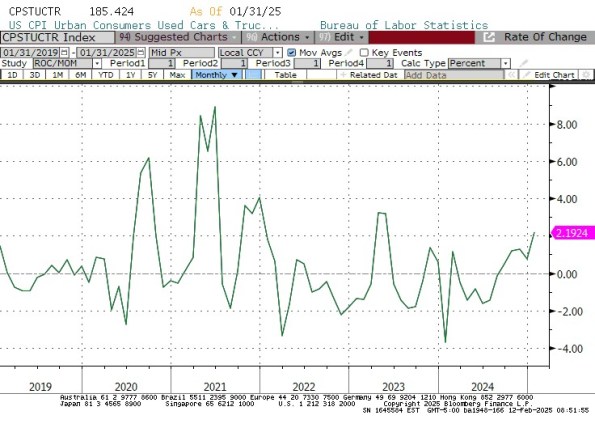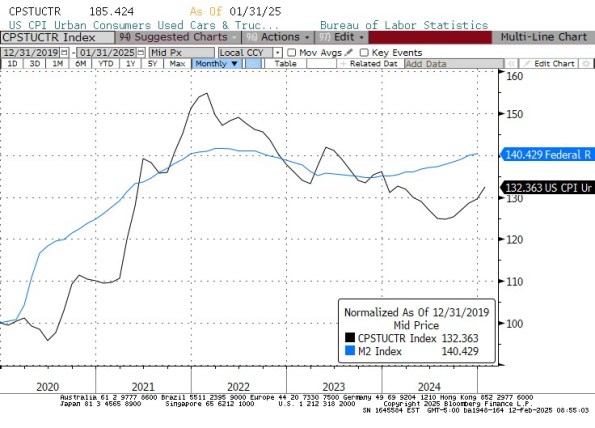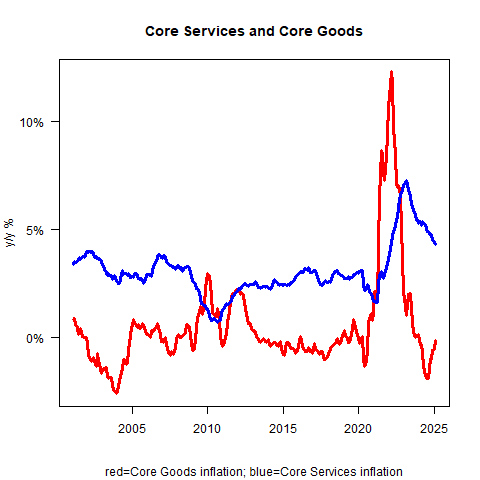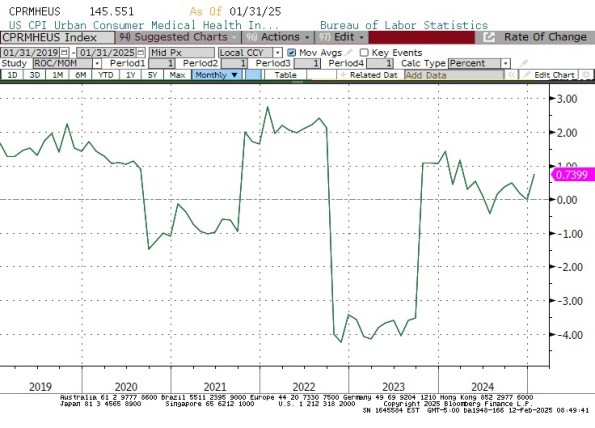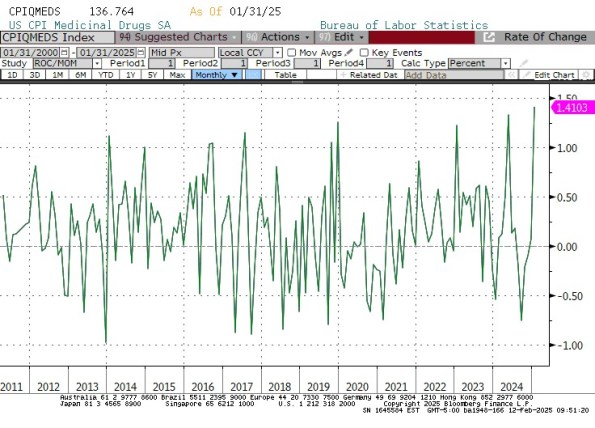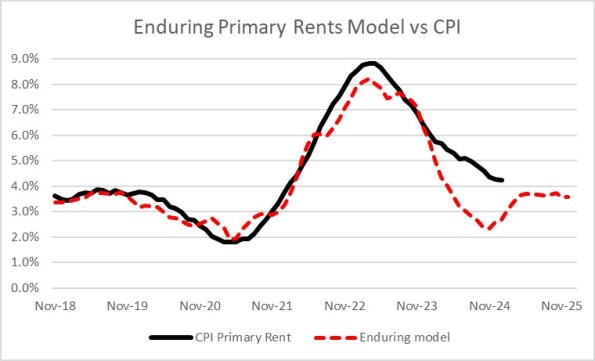We finished 2024 with a slightly soft reading, but we began 2025 with a hot reading. Now, my admonition last month about the volatility of December data applies also to January data, although less so in CPI than in some other indicators. However, averaging December and January is probably the right approach.
It still doesn’t look great even if you do that.
Let’s start with the market changes over the last month. You can tell from the table below that short inflation expectations as measured by the column on the far left have come up some, although not as much as you might have expected given all of the concern about tariffs. (For what it’s worth, in this table you can ignore the huge increase in 1-year breakevens – there really isn’t any such animal per se, and Bloomberg’s choice of bonds to use for the 1-year can change that a lot. Focus on the inflation swaps, which is a purer measure.)
The consensus estimates coming into today were for +0.30% on Core CPI and +0.29% on headline CPI. That represented an acceleration over the nice inflation data we saw in December (the best core inflation print since July!), but was expected to be attributable to one-offs such as wildfire effects. In fact, the number printed at an alarming +0.47% on headline and +0.45% on Core CPI, the worst since April of 2023. Here are the last 12 months.
But we are jaded these days because we’ve seen higher figures. Let’s back out a bit. Prior to COVID, we hadn’t seen a Core CPI number this high since 1992!
Okay, so some of these are one-off causes. And it is a January figure after all. Median CPI will be better. My calculation had it around 0.35%, but since the BLS changed weights for the new year in this report I am less confident in my estimate than usual. It should be close. And since last January was a big median print, that means the y/y median would drop to 3.66% or so on base effects. But there certainly doesn’t look to be any really marked improvement here.
Speaking of the reweighting of the CPI: this always sparks conspiracy theories even though the reweighting is very transparent. And the changes are pretty small year to year. Here are the changes from last January’s weights.
The BLS also announces categories that are being dropped or added or renamed. I never point those out because it’s really boring. At least, it is normally. This year, the BLS announced that the series for “Pet Food” has been renamed to “Pet Food and Treats.” Because who’s a good boy? That’s right, you’re a good boy.
Let’s look at some of the main culprits for the upside miss this month.
- Used Cars SA +2.19% m/m – We all expect some upward lift after the wildfires, but I am not sure this is due to that. New Cars CPI only rose +0.04%. But this is the highest m/m increase in Used Cars since 2023
A bigger concern with Used cars is the upward tilt in the overall price level. Remember that the spike during COVID (which happened thanks to the geyser of money that sprayed American consumers who had little else to buy, and few new cars being produced) was a big bellwether and/or driver (mathematically speaking) of the increase in core CPI post COVID. The unwinding of the spike in used cars pushed Core Goods inflation lower and lower, and dragged down Core CPI. But now it looks liked used car prices are again headed higher. This seems a good time to mention that M2 is also inflecting higher. The money supply is 40% bigger than at the end of 2019. Used car prices are only 32% higher. I think the deflation in used cars is over. (I’ve included M2 on this chart.)
AS a consequence of this, and despite apparel being -1.4% m/m (that’s one place tariffs could bite since we don’t produce any apparel in the US…on the other hand, there are lots of suppliers of apparel globally so absent a blanket tariff, we might not see a big effect), Core Goods CPI y/y went to -0.10% from -0.50%. As I’ve noted previously – ad nauseum, probably – to get inflation to 2% you need core goods inflation to stay negative, and pretty decently so. Core Services dipped to 4.3% y/y from 4.4% y/y, but obviously if that part is over 4%, and it’s the bigger part, you need Core Goods to stay flaccid.
- Health Insurance rose +0.74% NSA. Health insurance inflation jumps sometimes in January, so this is not something I’m worried about (plus, the health insurance number is really only calculated once a year and smeared out over the year). But it’s worth noting.
- Lodging Away from Home, +1.43% SA. Normally this is one of those categories that jumps around a lot and so we would expect a reversal next month, but with the wildfires in California I’d expect this to be buoyant for a while even if it is just the Western US being affected. But don’t forget that there are lots of people without homes still in North Carolina. On the other hand, if deportations ramp up a lot more than they currently are this is one place where pressure on prices could be relieved since many illegal aliens are housed in hotels at the expense of the local/state/federal government. That disinflationary effect, though, is months away at best, I think.
- Pharma had a huge month, rising 1.4% m/m SA. That’s the biggest monthly gain in decades. I suspect some of that is because pharmaceutical companies know that they are ‘on the X’ of President Trump’s ire after actively working against him in 2020. The President has recently been talking about how upset he is about US drug prices relative to the same drugs sold in other countries. This is a real threat – in his prior term, he talked about implementing a “Most Favored Nation” clause when it comes to pharmaceuticals (I wrote about it here). So it strikes me as possible that pharmaceutical companies were raising prices in January partly so that they can cut them with great theatrics to show their ‘support’ for the President (and hold off most-favored-nation as long as possible). I do not expect to see this repeated next month, unless tariffs affect APIs (active pharmaceutical ingredients) in the near-term.
- Hospital Services were also high, at +0.95% m/m SA, but this is less unusual for that series which jumps around a lot like Lodging Away from Home. Still, that was the highest print since March.
On the good side – while Rent of Primary Residence was a little higher than last month (+0.35% vs +0.30%), OER was the same (+0.31%) and rents overall continue to decelerate. However, they are decelerating at a declining rate. It looks like the dip that I expected is never going to happen, as the growth rate of rents looks to be converging with our model in the high 3s. And it doesn’t need to be repeated, but I will anyway, that there is no sign of broad deflation in rents coming.
Food and energy were additive this month, although less than I expected. Food at home was +0.46% m/m, and I expected about double that. Eggs were +13.8% m/m (NSA), and +53% y/y, and are getting a lot of press. But that’s not an inflation thing, that’s a lack-of-chickens thing and egg prices will eventually come down (in, approximately, the time it takes a chicken to get to adulthood). Food away from home was relatively tame at +0.24%.
So what’s the big picture?
What we saw today was mostly the trend. I continue to think that the new ‘middle’ on Median CPI is the high 3%s, low 4%s area, with occasional forays above and below that level. Over the course of 2025, as tariffs are implemented, we are likely to see a slightly higher run rate. Tariffs are a one-off, and they aren’t a large effect unless applied in a blanket way to all imports. Remember (and review my recent blog and podcast on the topic) that despite what some hyperventilating Congresspeople say, consumers do not usually pay the majority of a tariff except in narrow circumstances where demand for the good from that particular supplier is inelastic. If the Trump Administration imposes a blanket tariff of 20% on all imports, with no exceptions, it might cause an increase in inflation of 0.5%-1.0%. But that’s a one-time (level) effect unless tariffs keep being ramped higher, and the effect gets smaller the higher the tariff goes (a 1000% tariff will not raise prices any more than a 900% tariff, because at that point we aren’t importing anything). So, all else equal, we should expect slightly higher inflation in 2025 than we previously would have expected, and probably for the first part of 2026, but then the tariff effect will be over and the level of inflation we settle in at will be once again driven mainly by money growth.
On that score the news isn’t great, with M2 rising at a 5.8% annualized rate over the last quarter and 3.9% over the last year. 4% would get us to 1.5%-2% inflation in the long run, probably; 6% will get us into the high 3s, low 4s. Some think that if inflation ends up ratcheting a little higher, the Fed might raise interest rates again. But monetary policy has very little control over inflation that is caused by tariffs and it would make no sense to reverse course for that reason. This just accentuates how bad the box is that the Fed got itself into by making a nakedly political ease in the middle of last year. Tightening because of tariffs has no economic justification; it would look nakedly political again. I would be surprised if overnight rates went higher from here. Of course, I’d also be surprised to see them going lower especially since tariffs are also good for domestic economic growth.
So there will continue to be lots of economic volatility from here, but stasis appears to be high 3s, low 4s. Still.


